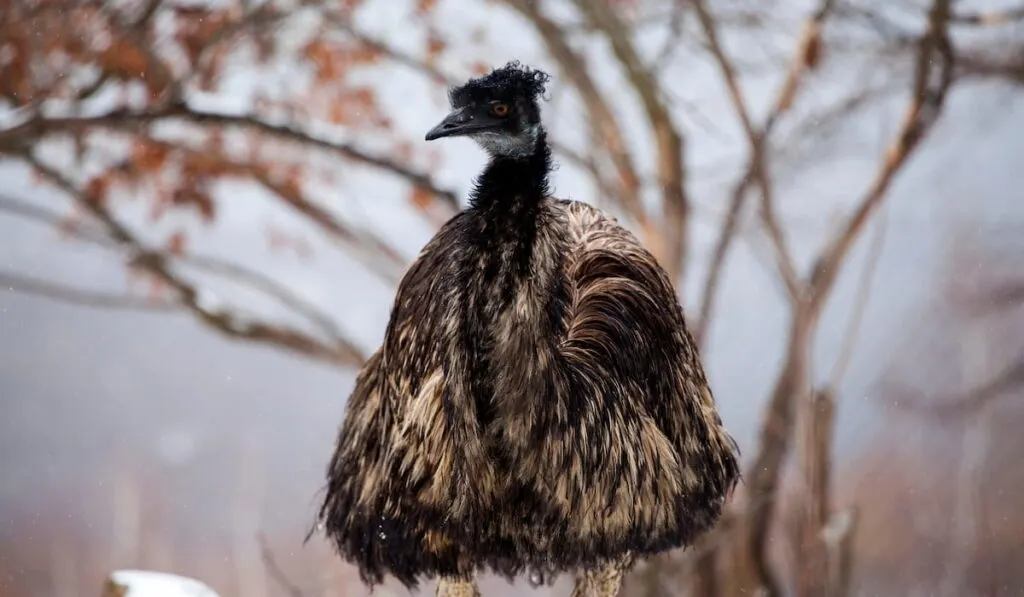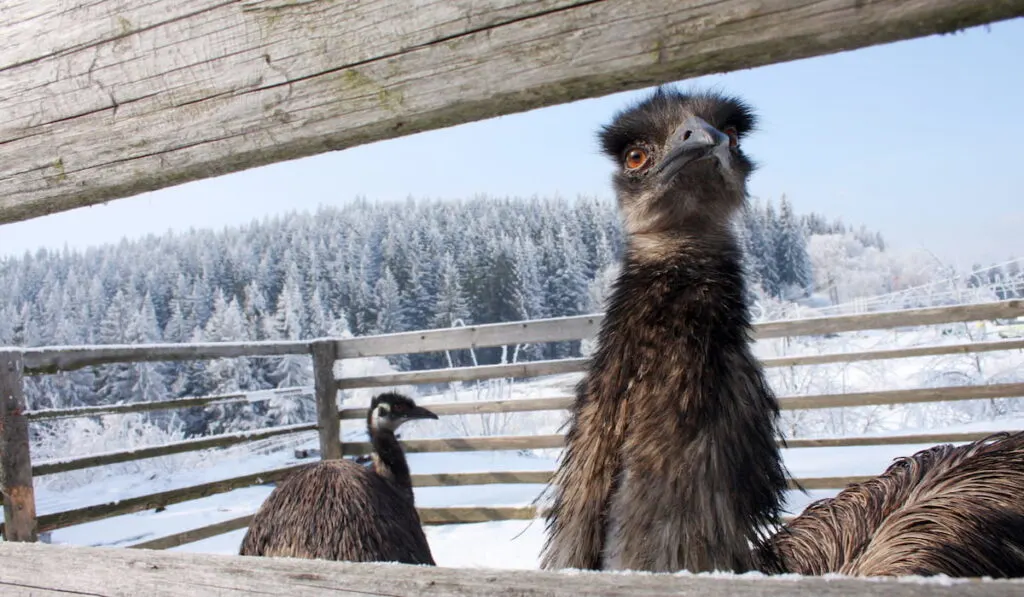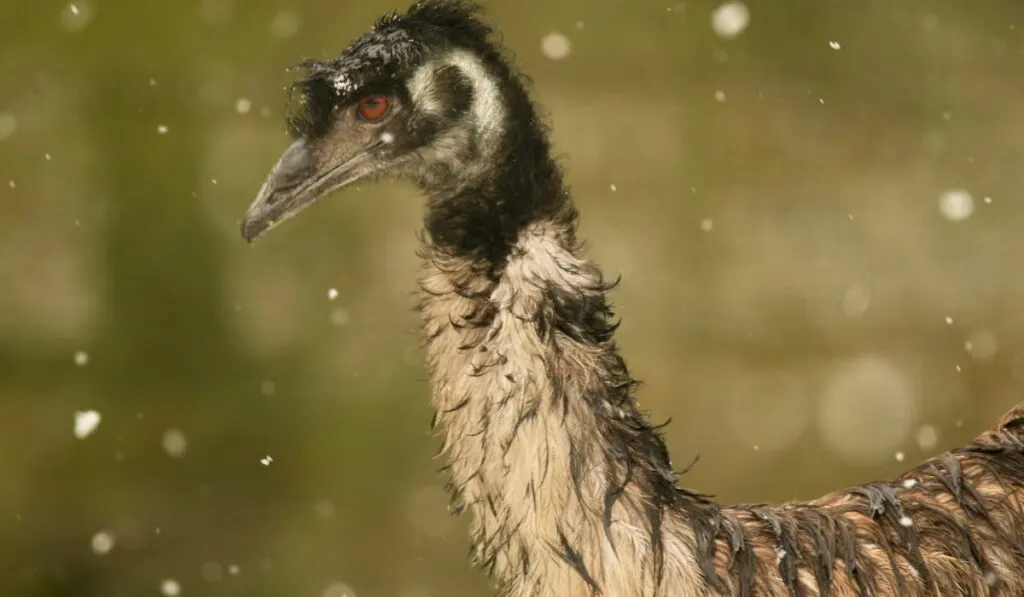When seasons like winter come, most living things find ways to resist or adapt to the intensity of the weather. Then again, some creatures are only mildly affected by moderate cold.
You may have seen emus casually walking around in the snow, and that makes you wonder, can emus live in cold weather? Let’s see.
Can emus live in cold weather?
Thanks to various anatomical adaptations, emus can live in cold weather. However, as expected, their ability to survive is limited.
In fact, like many other birds, wild emus migrate seasonally. In summer, they go north, and in winter, they go south.
So, what are the limitations for emus in cold weather? Well, we answer that question and more in this article.

Table of Contents
Can Emus Live in Cold Weather?
Emus can live in cold weather. They survive some pretty cold temperatures thanks to various adaptations.
Some Features That Help Emus Survive in Cold Weather
One of a few adaptations that help emus thrive in cold weather is their long feathers. Emus are tall, large-sized birds, and accordingly, they have long feathers.
When it is cold, emus fluff their long feathers to trap air. The trapped air, in turn, offers some insulation to these big birds.
Besides their feathers, emu nasal passages are large-sized and multi-folded, and this helps them breathe when it is cold.
Folds in the nasal passage ordinarily help warm and moisten air during breathing. But this effect is heightened in emus since theirs are large and multi-folded.
A study revealed that emus can maintain their body temperature even at temperatures as low as 23°F. This ability is driven by two main processes: reduced conductance and increased heat production. (source)
As the temperature falls, emus maintain their body temperature by reducing heat loss to the outside air. This happens as they fluff their feathers away from their bodies to create a cushion of air they can maintain at a temperature.
Then as it gets colder, they switch to increasing heat production.
At around 23°F, emus increase their metabolic rate almost 3 times to sustain their body temperature. However, the increase in metabolic rate may just be 1.5 times if the emu is sitting. This is because when emus are seated, their feathers insulate their legs. So, the overall heat needed by the body is lower.
Limitations to the Survival of Emus in Cold Weather
As we said before, the tolerance of emus to cold and its effects is not unlimited. When these birds are exposed to windy or wet conditions in the cold, they may suffer frostbite. This is why it is essential to provide them a dry shelter that keeps the wind out if you have emus.
Apart from the wind, the availability of food may also limit the ability of emus to survive in cold weather. While their bodies can take some frostiness, they need food to sustain their elevated metabolism.
Emus are migratory; they typically go to the north in summer and south in winter. Their migration in winter is not necessarily driven by the low temperatures. Instead, it is thought that they go in search of food.

How Cold Can They Tolerate?
So, how cold can emus tolerate?
As we explained earlier, emus can sustain their body temperature even at temperatures as low as 23°F. But since ostriches – their cousins – can tolerate temperatures as low as -22°F, emus might be able to survive at similar subzero temperatures.
Even if emus can possibly tolerate temperatures as low as -22°F, avoid exposing them to such. At most, you should not expose emus to temperatures below 10°F.
Rain?
Emus are able to tolerate mild to moderate rain. In fact, when they are in a deep sleep, they align their body in a way that allows their feathers to direct rain onto the ground.
However, emus may not tolerate heavy rains or storms. Under such conditions, their feathers will get wet and even saturated. If the feathers stay wet as such, thermoregulation will be hampered.
Emus do not have a waterproofing mechanism since their feather barbules do not interlock. So, if they get caught in drenching rain, their insulation may be affected.
While emus can maintain their body temperature by raising their metabolic rate, the rain may prevent them from moving around. If they cannot move around, they may not get enough food to sustain their elevated temperature.
Snow?
Emus can tolerate snow for short periods. They are known to move around in snow just fine. But they can only do this for short periods.
Blizzards might be an issue for emus because of the intensity of the snow, the strong winds, and the poor visibility.
Emus are particularly sensitive to wet-cold conditions. They do not have waterproofing because their barbules do not interlock. So, the cold gets to them with more ease.

5 Tips for Keeping Your Emu Warm and Dry
Install Heating in Extreme Cold
Adult emus do not necessarily need heating. But in severely cold temperatures, you can install infrared heating in their pen.
Ensure the Shelter Is Spacious
The shelter should offer a space of at least 43 square feet for each emu, and the roof should be at least 12 inches above the heads of the emus.
As with domestic birds, insufficient space may cause emus to tip water buckets over. When this happens, the pen gets wet. So, ensure there is enough space for each bird.
Seal All Air Leaks
Ensure the leaks in their pen are well sealed. This way, there will be fewer drafts to make the birds cold.
Install the Ventilation System Close to the Roof
Make sure any ventilation system in the shelter is installed very close to the roof. This way, cold air will not get to the birds directly. Also, warm, damp air can escape while cool, dry air takes its place. Consequently, humidity is kept at a low.
Raise the Thermal Mass of the Shelter to Trap Some Solar Heat
Increase the thermal mass of the pen to help maintain some heat. You can install dark slab floors, stones, and insulated windows to achieve this. The said items will raise the thermal mass of the shelter and help trap heat from the sun. So, even after the sun is long gone, they will still bear some heat, which they will release slowly to the rest of the pen.
Build a Deep Litter
Lay some pine shavings in the shelter as bedding. As the emus release their waste on the shavings, rake the bedding lightly.
After a while, add a new layer of pine shavings on the old one and keep doing this regularly. When you do this, microbes will begin to compost the waste from the emus.
As the compost is formed, heat is generated. The generated heat can help keep the birds warm. Besides, composting makes waste management less tedious.
Final Thoughts
Emus can live in cold weather. They tolerate temperatures as low as 23°F while maintaining their body temperature. But as the temperature falls below 23° you should start considering sheltering them.
Emus are particularly sensitive to cold, wet conditions. So, ensure the shelter you provide for them is dry and warm.
Resources
- https://nationalzoo.si.edu/animals/emu
- http://www.nelsonroadvet.com/articles/large-animal-exotics/ratites-flightless-birds/raising-emus/
- https://a-z-animals.com/animals/emu/
- https://animalcorner.org/animals/emu/
- https://my.clevelandclinic.org/health/body/21778-nose
- https://link.springer.com/article/10.1007/BF00714584
- https://www.nationalgeographic.com/animals/birds/facts/common-emu
- http://www.sybilsden.com/caresheet/emus.htm
- https://www.arubaostrichfarm.com/ostrich-facts/
- https://www.audubon.org/news/why-do-birds-avoid-flying-rain
- https://doi.org/10.1071%2FMU960193
- https://www.natureoutside.com/where-do-birds-go-when-it-rains/
- https://www.sciencedirect.com/topics/immunology-and-microbiology/emu
- https://www.doc-developpement-durable.org/file/Elevages/autruches&Emeus/ostrich_emu_leaflet.pdf
- https://www.scoopfromthecoop.com/say-no-to-crowded-coops/
- https://www.thepoultrysite.com/news/2018/12/how-to-keep-your-chickens-warm-in-winter
